From the Trenches
A Dangerous Island
By JASON URBANUS
Monday, June 12, 2017
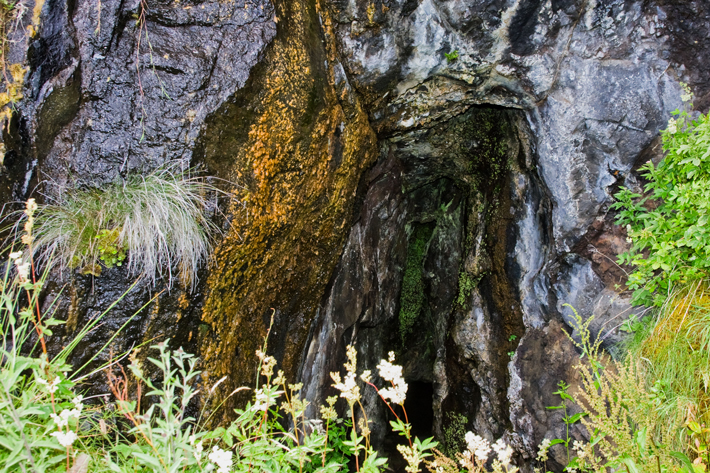 Tourists exploring Scotland’s Isle of Eigg recently called police when they found human bones lying in a cave, possible remnants of the area’s gruesome past. Legend holds that in 1577, nearly the entire MacDonald clan of the island was murdered by rival MacLeods from Skye as a result of a generations-long feud. The MacDonalds were hiding in the cave when they were discovered by a vengeful party of MacLeods, who, the story goes, blocked the entrance with vegetation and set it on fire. Almost 400 MacDonalds suffocated and died in what came to be known as Uamh Fharaing, or “Massacre Cave.”
Tourists exploring Scotland’s Isle of Eigg recently called police when they found human bones lying in a cave, possible remnants of the area’s gruesome past. Legend holds that in 1577, nearly the entire MacDonald clan of the island was murdered by rival MacLeods from Skye as a result of a generations-long feud. The MacDonalds were hiding in the cave when they were discovered by a vengeful party of MacLeods, who, the story goes, blocked the entrance with vegetation and set it on fire. Almost 400 MacDonalds suffocated and died in what came to be known as Uamh Fharaing, or “Massacre Cave.”
Following a trend set by Sir Walter Scott, who brought a skull from the cave back to his house at Abbotsford, curious travelers to Eigg during the eighteenth and nineteenth centuries occasionally carried off skeletal parts found in the cave as souvenirs, despite the fact that most of the bones were removed and buried in the island’s graveyard after the massacre, says Camille Dressler of the Eigg History Society. Recently, though, natural disturbances in the soil exposed additional remains, and the criminal investigation team alerted by the modern tourists was able to retrieve 53 bones now known to belong to a single individual around 16 years old. According to radiocarbon results, the bones date to between 1430 and 1620, perhaps tying them to the notorious massacre. Historic Environment Scotland archaeologist Kirsty Owen plans to commission more radiocarbon dating, as well as isotopic analysis and possibly DNA work, in the hopes of narrowing the date range.
While You Are Waiting
By ROSSELLA LORENZI
Monday, June 12, 2017
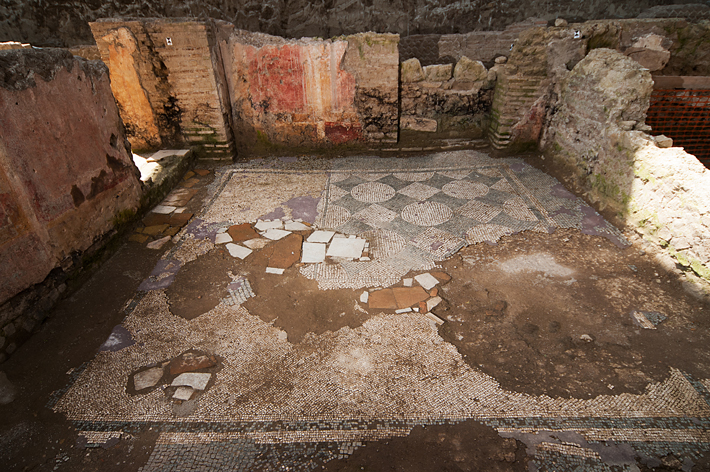
Authorities in Rome have approved a plan to build a metro station similar to underground “museums” in the metro systems of Naples, Athens, Porto, and Vienna. The Amba Aradam stop of the metro’s new “C” line will be constructed near the Colosseum around an impressive second-century A.D. Roman barracks. The ruins, covering some 10,000 square feet, were found about 30 feet below street level as excavations for the station began. The ancient complex includes a 328-foot-long hallway with 39 rooms decorated with frescoed walls and black-and-white mosaic floors. According to Rossella Rea, scientific director of the archaeological excavation, the site was the garrison of the Praetorian Guard, an elite security force for Roman emperors. A grave containing 13 skeletons, most likely of soldiers, was also uncovered, along with a bronze coin and a bronze bracelet.
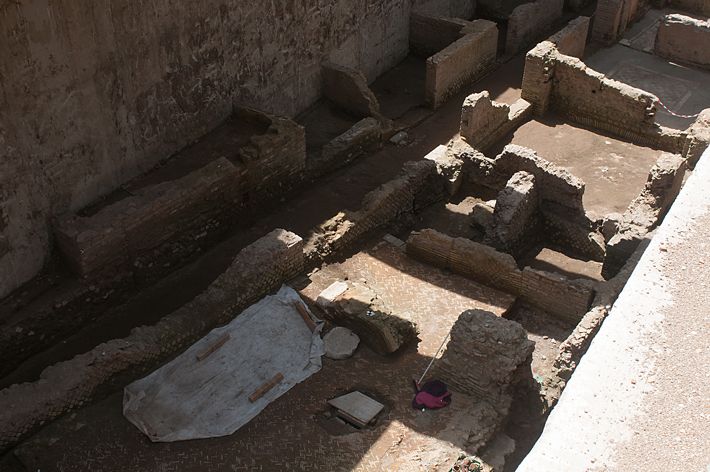 “The barracks were abandoned and completely forgotten in the third century A.D., when the Aurelian Walls were built to protect Rome against attacks,” says Rea. Now, after more than 1,700 years spent in oblivion, the garrison is poised to return to its original hustle and bustle—but not without precautions being taken. Project architect Paolo Desideri says, “The new line requires us to excavate to a depth of 130 feet, so the entire ancient Roman site will be moved and stored safely. Later, the barracks will be replaced at their original depth.” Passengers catching a train will be able to see the barracks through a large glass window. Desideri explains that the Aurelian Walls will also be exposed, so commuters can have the same view that people had in antiquity.
“The barracks were abandoned and completely forgotten in the third century A.D., when the Aurelian Walls were built to protect Rome against attacks,” says Rea. Now, after more than 1,700 years spent in oblivion, the garrison is poised to return to its original hustle and bustle—but not without precautions being taken. Project architect Paolo Desideri says, “The new line requires us to excavate to a depth of 130 feet, so the entire ancient Roman site will be moved and stored safely. Later, the barracks will be replaced at their original depth.” Passengers catching a train will be able to see the barracks through a large glass window. Desideri explains that the Aurelian Walls will also be exposed, so commuters can have the same view that people had in antiquity.
Ka-Ching!
By DANIEL WEISS
Monday, June 12, 2017
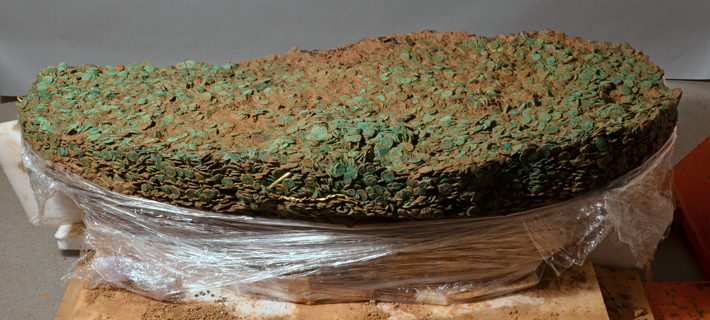
In 2012, a pair of veteran metal detectorists on Jersey in the British Channel Islands discovered a gargantuan coin hoard in a field they had been searching off and on for three decades. The hoard was the largest ever to have been found in Britain and appeared to have the potential to transform interpretations of Jersey’s history. But first it had to be moved. Just getting it out of the ground was fraught with tension. “With earth still attached, it weighed over a ton,” says Neil Mahrer, a museum conservator with Jersey Heritage. “We had no idea how strong it was, in that it was only held together by the corrosion between the coins.”
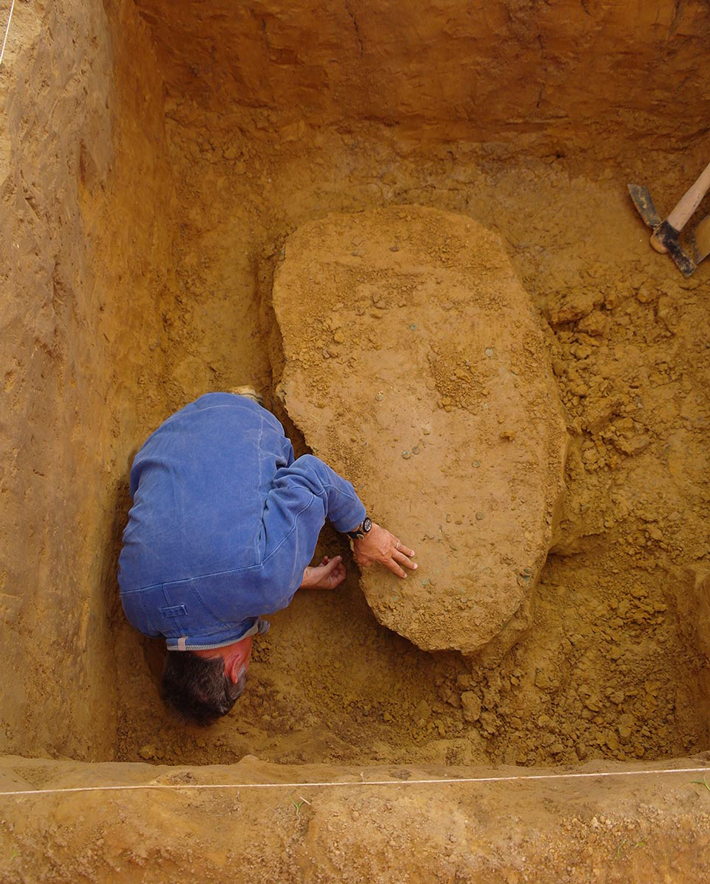 Once the hoard was safely in the laboratory in the Jersey Museum in mid-2014, Mahrer and his team faced the next challenge: how to disassemble it. They also had a daunting deadline. Based on their funding, they needed to take it apart within three years. This would mean extricating almost 500 coins per week on average. Early on, their pace lagged as they learned to use a metrology arm that recorded the position of each coin to within one five-hundredth of an inch. A year into the project, though, with the help of a team of volunteers, they were removing up to 800 coins per week.
Once the hoard was safely in the laboratory in the Jersey Museum in mid-2014, Mahrer and his team faced the next challenge: how to disassemble it. They also had a daunting deadline. Based on their funding, they needed to take it apart within three years. This would mean extricating almost 500 coins per week on average. Early on, their pace lagged as they learned to use a metrology arm that recorded the position of each coin to within one five-hundredth of an inch. A year into the project, though, with the help of a team of volunteers, they were removing up to 800 coins per week.
Along the way, Mahrer sought advice from the small club of fellow conservators with experience taking apart large hoards. To remove the corrosion from the coins, which were generally made with an alloy of silver and copper, experts at the British Museum recommended using a dilute solution of formic acid. To clean the gold jewelry embedded along with the coins—including up to 17 partial and complete gold torques—conservators who worked on the Staffordshire Anglo-Saxon hoard advised using thorns from the evergreen barberry shrub. “It turns out that this one particular thorn is soft enough not to scratch the gold surface, but will remove the corrosion and dirt,” says Mahrer. “It’s strange to think that the best way to clean these was a technique that could have been used as far back into the past as one goes.”
In late January 2017, months before the three-year deadline, the final pieces were detached. “We had to take this thing apart literally one coin at a time while having no idea what was inside,” says Mahrer. “Right up to the end, we were surprised all the time by finding new things.” The tally of coins now stands at around an astounding 69,000, though this includes an estimate of the number contained in a small cylindrical section set aside intact for future study.
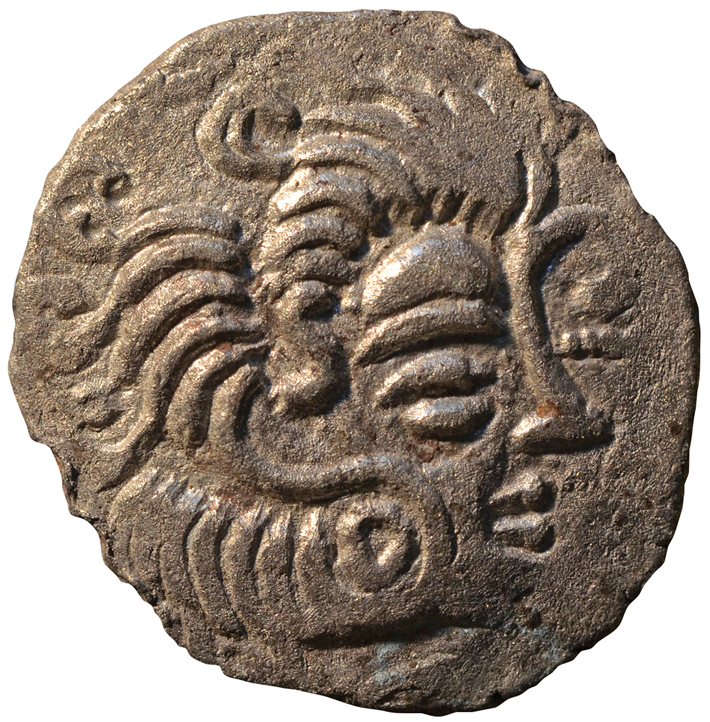 The great majority of the coins have been associated with the Coriosolites, a Celtic tribe known to have controlled a small area of mainland France close to Jersey. Originally, the hoard was thought to have been buried for safekeeping around 50 B.C., when the Romans were making their way through France, conquering Celtic tribes as they went. However, Olga Finch, head of archaeology at Jersey Heritage, notes that a smattering of the coins are thought to date to around 40 B.C., suggesting the hoard may have been buried after the conquest. Even given this later dating, it might still represent an attempt to hide wealth from the Romans. It’s also possible that the hoard—and a number of others that have been found on Jersey—was left with no intention of recovery. “Maybe it’s not about hiding your wealth,” says Finch. “Maybe it’s more about ritual and showing that you have so much wealth that you can afford to bury some of it as an offering to the gods.” To watch a time-lapse video of the team disassembling the hoard, click below.
The great majority of the coins have been associated with the Coriosolites, a Celtic tribe known to have controlled a small area of mainland France close to Jersey. Originally, the hoard was thought to have been buried for safekeeping around 50 B.C., when the Romans were making their way through France, conquering Celtic tribes as they went. However, Olga Finch, head of archaeology at Jersey Heritage, notes that a smattering of the coins are thought to date to around 40 B.C., suggesting the hoard may have been buried after the conquest. Even given this later dating, it might still represent an attempt to hide wealth from the Romans. It’s also possible that the hoard—and a number of others that have been found on Jersey—was left with no intention of recovery. “Maybe it’s not about hiding your wealth,” says Finch. “Maybe it’s more about ritual and showing that you have so much wealth that you can afford to bury some of it as an offering to the gods.” To watch a time-lapse video of the team disassembling the hoard, click below.
Off the Grid
By MALIN GRUNBERG BANYASZ
Monday, June 12, 2017
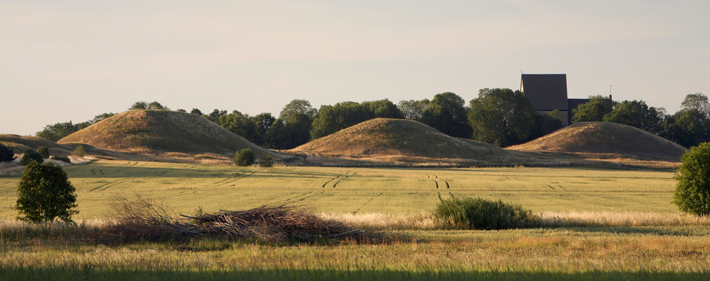
Legend, historical accounts, and archaeology are in agreement that Gamla Uppsala, in southeastern Sweden, was the home and burial place of the kings of the fifth- and sixth-century Ynglinga Dynasty. These monarchs reigned during the time depicted in the Old English epic poem Beowulf. Until the arrival of Christianity, Gamla Uppsala was long regarded throughout Northern Europe as an important and sacred location and was ultimately graced by palaces, a great pagan temple, and a royal burial ground. John Ljungkvist of Gamla Uppsala University says, “These rulers transformed the entire landscape to showcase what they thought was their divine lineage.” He adds, “These monuments made Uppsala a central assembly place for nearly 1,000 years. It’s Beowulf, for real.” Today, of some 300 remaining funerary barrows, three mounds in particular, measuring between 29 and 32 feet in height, have special significance. Mythological sources identify them as belonging to the gods Thor, Odin, and Freyr, while legends state that the mounds held the remains of Ynglinga royalty. Excavations of one of the mounds began in 1846 at the instigation of the future king Karl XV (r. 1859–1872) in order to respond to what he saw as spurious claims that the mounds were simply natural landscape formations. Archaeologists, however, confirmed that there were funerary remains there, and in another of the three mounds, which was dug in 1874. All agree that the burials were princely.
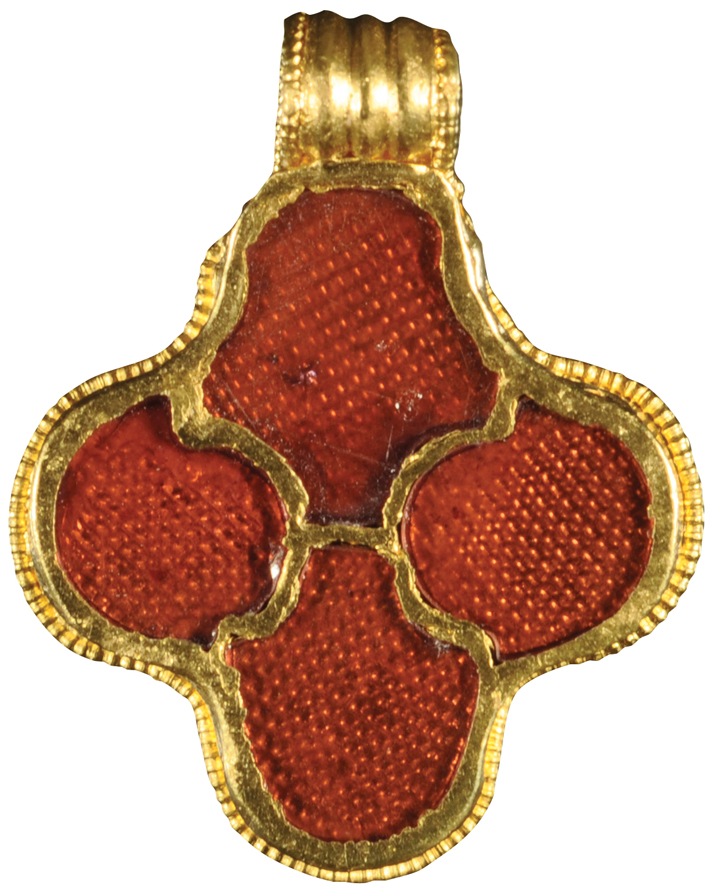 The site
The site
The three royal mounds at Gamla Uppsala are termed Eastern Mound, Middle Mound, and Western Mound. The first excavation, in 1846, was begun on the Eastern Mound by Bror Emil Hildebrand. There he discovered an urn holding burned bones and charred grave offerings. The grave, surprisingly, held the remains of a woman and a boy, cremated and interred according to fifth- and sixth-century Scandinavian practice. In 1874, the Western Mound was found to contain a man—likely a warrior, since military equipage was uncovered along with high-quality weaponry. Ivory game pieces and cameos unearthed in the burial suggest strong trade ties reaching as far as the Mediterranean. While the Middle Mound has, as yet, not been fully excavated, in the course of digs beginning in 2012 researchers have focused on the area encircling the mounds where dwellings, outbuildings, and a variety of artifacts from everyday life—and from all classes of society—are being uncovered.
While you’re there
The museum at Gamla Uppsala features archaeological finds from the site. A composite model and a timeline help place Gamla Uppsala and its eventful Nordic history in context. In the summer months, you can take a guided tour, or you can follow an app on your phone. Once you’ve worked up an appetite, head over to the Odinsborg restaurant right next to the museum.
Advertisement
Advertisement
IN THIS ISSUE
From the Trenches
Ka-Ching!
Off the Grid
While You Are Waiting
A Dangerous Island
House Rules
Renaissance Melody
Take Me Out to the Ball Game
Tomb Couture
Not So Pearly Whites
Late Paleolithic Masterpieces
Afterlife on the Nile
Knight Watch
The Grand Army Diet
Angry Birds
World Roundup
First World War booze, Russian bear grease, Mediterranean mystery religion, and exploring under Algiers
Artifact
A venerable bead
Advertisement

Recent Issues
-
 May/June 2024
May/June 2024
-
 March/April 2024
March/April 2024
-
 January/February 2024
January/February 2024
-
 November/December 2023
November/December 2023
-
 September/October 2023
September/October 2023
-
 July/August 2023
July/August 2023
-
 May/June 2023
May/June 2023
-
 March/April 2023
March/April 2023
-
 January/February 2023
January/February 2023
-
 November/December 2022
November/December 2022
-
 September/October 2022
September/October 2022
-
 July/August 2022
July/August 2022
-
 May/June 2022
May/June 2022
-
 March/April 2022
March/April 2022
-
 January/February 2022
January/February 2022
-
 November/December 2021
November/December 2021
-
 September/October 2021
September/October 2021
-
 July/August 2021
July/August 2021
-
 May/June 2021
May/June 2021
-
 March/April 2021
March/April 2021
-
 January/February 2021
January/February 2021
-
 November/December 2020
November/December 2020
-
 September/October 2020
September/October 2020
-
 July/August 2020
July/August 2020
-
 May/June 2020
May/June 2020
-
 March/April 2020
March/April 2020
-
 January/February 2020
January/February 2020
-
 November/December 2019
November/December 2019
-
 September/October 2019
September/October 2019
-
 July/August 2019
July/August 2019
-
 May/June 2019
May/June 2019
-
 March/April 2019
March/April 2019
-
 January/February 2019
January/February 2019
-
 November/December 2018
November/December 2018
-
 September/October 2018
September/October 2018
-
 July/August 2018
July/August 2018
-
 May/June 2018
May/June 2018
-
 March/April 2018
March/April 2018
-
 January/February 2018
January/February 2018
-
 November/December 2017
November/December 2017
-
 September/October 2017
September/October 2017
-
 July/August 2017
July/August 2017
-
 May/June 2017
May/June 2017
-
 March/April 2017
March/April 2017
-
 January/February 2017
January/February 2017
-
 November/December 2016
November/December 2016
-
 September/October 2016
September/October 2016
-
 July/August 2016
July/August 2016
-
 May/June 2016
May/June 2016
-
 March/April 2016
March/April 2016
-
 January/February 2016
January/February 2016
-
 November/December 2015
November/December 2015
-
 September/October 2015
September/October 2015
-
 July/August 2015
July/August 2015
-
 May/June 2015
May/June 2015
-
 March/April 2015
March/April 2015
-
 January/February 2015
January/February 2015
-
 November/December 2014
November/December 2014
-
 September/October 2014
September/October 2014
-
 July/August 2014
July/August 2014
-
 May/June 2014
May/June 2014
-
 March/April 2014
March/April 2014
-
 January/February 2014
January/February 2014
-
 November/December 2013
November/December 2013
-
 September/October 2013
September/October 2013
-
 July/August 2013
July/August 2013
-
 May/June 2013
May/June 2013
-
 March/April 2013
March/April 2013
-
 January/February 2013
January/February 2013
-
 November/December 2012
November/December 2012
-
 September/October 2012
September/October 2012
-
 July/August 2012
July/August 2012
-
 May/June 2012
May/June 2012
-
 March/April 2012
March/April 2012
-
 January/February 2012
January/February 2012
-
 November/December 2011
November/December 2011
-
 September/October 2011
September/October 2011
-
 July/August 2011
July/August 2011
-
 May/June 2011
May/June 2011
-
 March/April 2011
March/April 2011
-
 January/February 2011
January/February 2011
Advertisement






